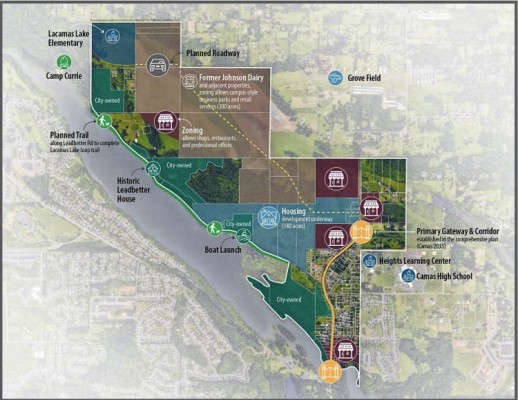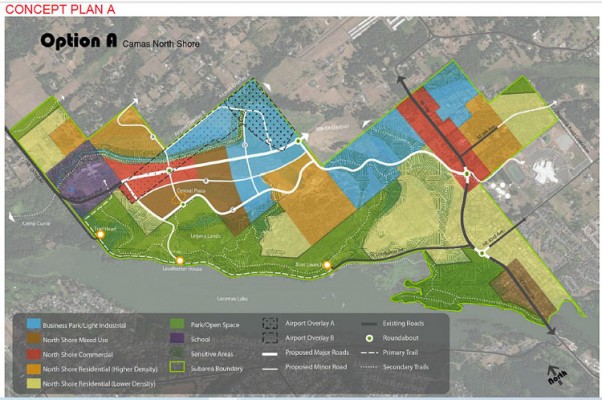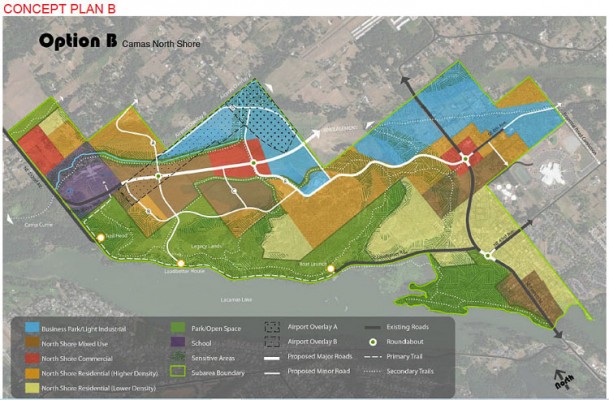Camas moves forward with development plans for North Shore sub area
At Wednesday evening’s Camas Parks and Recreation Commission meeting, citizens got their first peek at two possible options for the North Shore development of Lacamas Lake. In the past few years, the city has recently acquired roughly 140 acres of North Shore land for $22 million, in what has been called “Legacy Lands.” Many citizens believed these were being set aside to reduce development along the North Shore.
The members were shown two options city planning staff and their WSP USA consultants had created. This was supposedly based on community input and surveys, and an effort to comply with Growth Management Act (GMA) requirements for 20-year planning to accommodate growth.
The North Shore of Lacamas Lake is an estimated 990-acre area of largely undeveloped lands. There are several large farms, some city-owned lands, and many rural homes on acreage. This is contrasted by the developed southern shore of Lacamas Lake. It has the Camas Meadows Golf Course on the western end, many subdivisions, and then Heritage Park and city-owned Lacamas Lake Lodge on the eastern end.
Lacamas Lake has been called “the jewel” of Camas. Properly handling development around the lake is of key interest to a significant number of residents. But for many years, the jewel has been tarnished by dirty water, as “caution” and “warning” signs were posted many months of the year indicating lake water was unsafe for people and their pets. A citizen has sued the city for failing to enforce clean water laws.
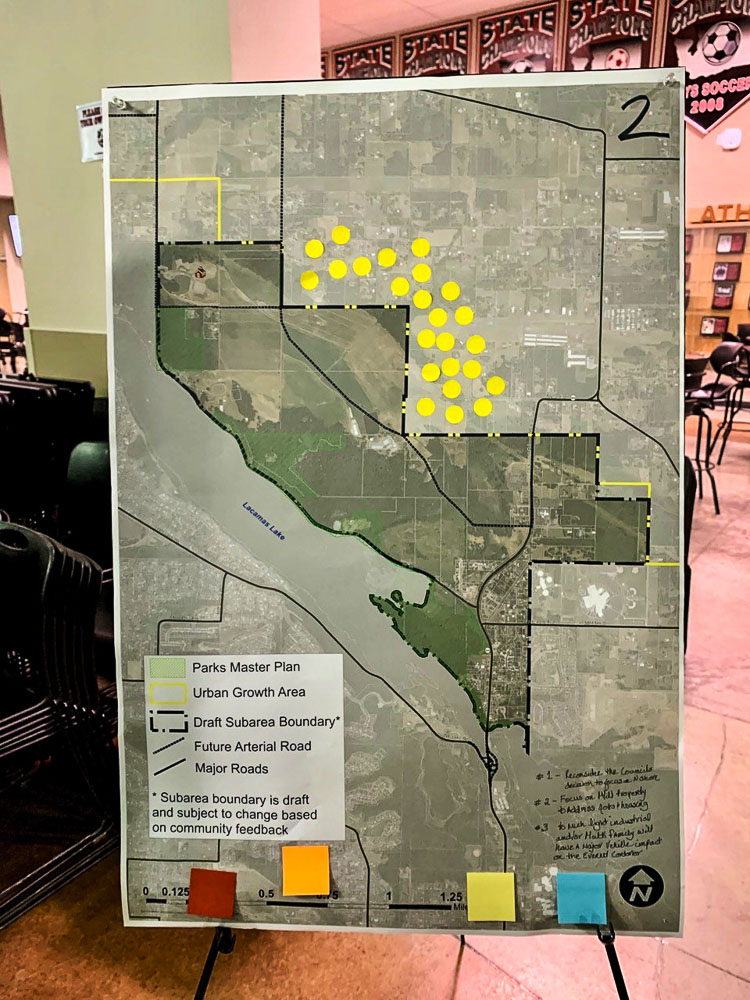
The two options revealed extensive parks along the southern part of the North Shore area, a new road system, and different colored areas of possible zoning. Staff revealed that one option was 23 percent parks and open space; 19 percent business park and light industrial; 21 percent residential split between high and low density, and the balance as mixed use and schools. The second option was 16 percent parks and open space; 19 percent business park and light industrial; 31 percent residential; and the balance mixed use and schools.
But citizen Randal Friedman pushed back hard during citizen comments. “A visioning workshop was well attended with many common points made,” he said. “Reminder: no one wanted more development than current zoning.”
He then chastised the officials at the meeting. There was no communication about tonight’s meeting and the availability of the two map proposals. Nothing was shared on the city’s social media page. Friedman had expressed concerns last year when a Steering Committee was formed and excluded public membership.
“Two maps – both with substantial development dumping traffic on our two-lane roads,” he said. “Never mind the ‘vision’ expressed by the public at the visioning workshop. These proposals are double and triple the existing zoning capacity per the staff’s document. Quite contrary to the people’s visioning process.”
Friedman continued. “So that’s what happens when the public isn’t invited. Maybe this is why staff is hiding this from the public. They certainly are not making an effort to engage the public.
“This explains why there are three lawsuits involving Community Development. We don’t seem to be learning.”
The sticky note exercise
Two years ago just prior to the pandemic, residents met at Camas High School, engaging in an exercise developed by consultant WSP USA and Camas planning staff. The goal was to solicit citizen input for the North Shore. But citizens rebelled at the meeting.
The “sticky note” exercise asked groups to put different colored post it notes in different places on maps of the North Shore. Each one served as a zoning code. One color marked single family homes; another multi family homes. A third color marked business development, and another marked light industrial. The drill had specific numbers of each sticky note, all required to be placed somewhere on the map.
There were about 18 separate groups participating. They created 18 maps with each group’s sticky notes. Each group was then asked to explain their maps and their considerations and issues.
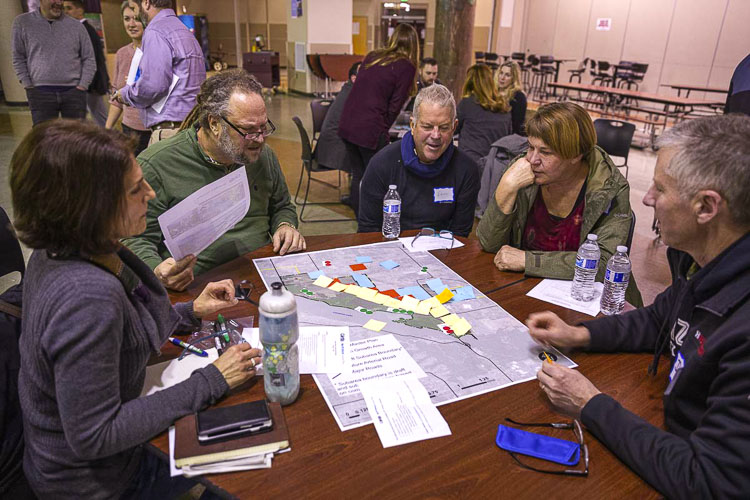
But one group rebelled. They refused to put their sticky notes on the North Shore map. They called themselves the “Rebels with a Cause.” They didn’t want the North Shore to be developed.
All 18 maps were placed on easels in an adjacent area at the end of the exercise. All the participants were then asked to go “vote” for the “plan” they preferred. They were given two round yellow “dots” to vote for their top two choices.
The citizens also rebelled. Overwhelmingly, they preferred the rebels map. They wanted no development of the North Shore at this time.
Words written on the bottom of the map tells the story.
- #1 – Reconsider council’s decision to focus on N shore.
- #2 – Focus on mill property to address jobs and housing
- #3 – to (sic) much light industrial and/or multi family will have a major vehicle impact on the Everett corridor
New Camas Mayor Barry McDonnell noted the outcome. “I think that that was the one that got the most attention … and they decided not to put any dots (sticky notes representing zoning) on the board, hence the “Rebel” I think, aspect of it.”
Citizens explained they preferred the high density apartments be placed downtown, near transit and other services. They pointed out many existing undeveloped areas where single family homes could be built, including Grass Valley, Green Mountain, and other areas of the city.
Mayor McDonnell would later remark on the “Rebels” map being the citizen’s favorite in the Feb. 18, 2020 City Council Workshop meeting. “I liked their name for their group,” he said. This was a passing comment by the mayor at the end of the Council Comments section of the meeting, but clearly the people had made an impression.
The original North Shore area is shown here. Camas officials are considering purchasing four properties to add to the city’s Legacy Lands. Then two possible options showing different potential locations for residential development, parks and open space, mixed use and light industrial development also. Finally, a new road network through the North Shore, since Ledbetter Rd. will be shut down. Graphics courtesy city of Camas
Planning manager Robert Maul presented the two maps, but emphasized that these were merely options to start the conversation among the Planning Commission and citizens. He emphasized that the GMA required the city to plan for expected growth 20 years into the future.
Camas growth
Camas is expected to grow by 11,800 people by 2040, a 47 percent increase. City officials noted manufacturing jobs have declined from 46 percent in 2002 to 26 percent in 2018. Job growth is predicted to occur primarily in education and health services, leisure and hospitality, government, and professional and business services.
The planning document noted that 85 percent of population growth from 2010 to 2018 were people aged 40 and older.
About 40 percent of projected future housing needs will be for units affordable to households with low or moderate incomes, with a mix of rental and for-sale housing. There is a lack of diverse housing types in the city, particularly units under 2,000 square feet according to planners.
Staff says that to accommodate the variety of new households anticipated, and to better serve existing households with difficulty affording their housing costs, Camas will need housing options “diverse in type, tenure, and cost.”
There was no mention of the fact that the cost of a building permit for a single family home on the North Shore has been mentioned to be as much as $30,000.
Existing zoning would allow for 651 acres to be developed of the 990 acres. Roughly one third of the land would not be developed. It allows for 1,008 multifamily units to be built, plus another 1,500 single family homes.
The possible options would reduce the number of potential jobs in the city that might be created on the North Shore by nearly 900 jobs in Option B. The other option reduces jobs by nearly 750 jobs. Both options reduce jobs compared to existing zoning.
The lands set aside for parks and schools removed the potential for up to 915 residential units and 416 jobs in the North Shore subarea. The GMA requires those residential units be placed elsewhere in city planning, hence the increase elsewhere.
Following his remarks, Friedman and other citizens were removed from the zoom meeting, and unable to rejoin for a period of time. “Technical difficulties” is how it was explained.
This became one more example of the city choosing to keep citizens from participating, according to Friedman. He sent a strongly worded letter to Mayor Steve Hogan the next day, labeling what was going on as “backroom politics.” He called for an independent investigation into how the staff treats the public, and a specific question about “bullying” of women.
“We are no longer a ‘company’ mill town,” Friedman said. “We do not have to accept being ignored, disrespected and bullied. We are not told what to do by the powers that be. It is no longer an ‘old boys network’ where the needs of the community are not put first.”
He reminded the mayor that three separate lawsuits have been filed against the city because of its planning program. “The presenter tonight is at the center of all three,” he wrote. “There’s commonality: they stem from the staff not taking public concerns seriously, then treating the public dismissively.”
Friedman had been one citizen who in the past had supported the city effort. Not any more.
“Where’s an Option 3 that makes open space more prominent than extending Vancouver into Camas?” he asked.
“Have some public integrity and postpone this item until staff follows what they have promised our citizens,” he said. “End the broken cycle of Camas planning.”
Citizen Doug Strabel has been following the North Shore development from the beginning. He shared with Clark County Today that WSP USA has a $320,000 contract with the city for the services they will provide as a consultant.
The city staff has planned for public hearings and input regarding the North Shore development and the possible “options” presented. This is supposed to begin next month. They say they want to hear from the people. Friedman wants to know if they will listen and then take action based upon the input of the people.




